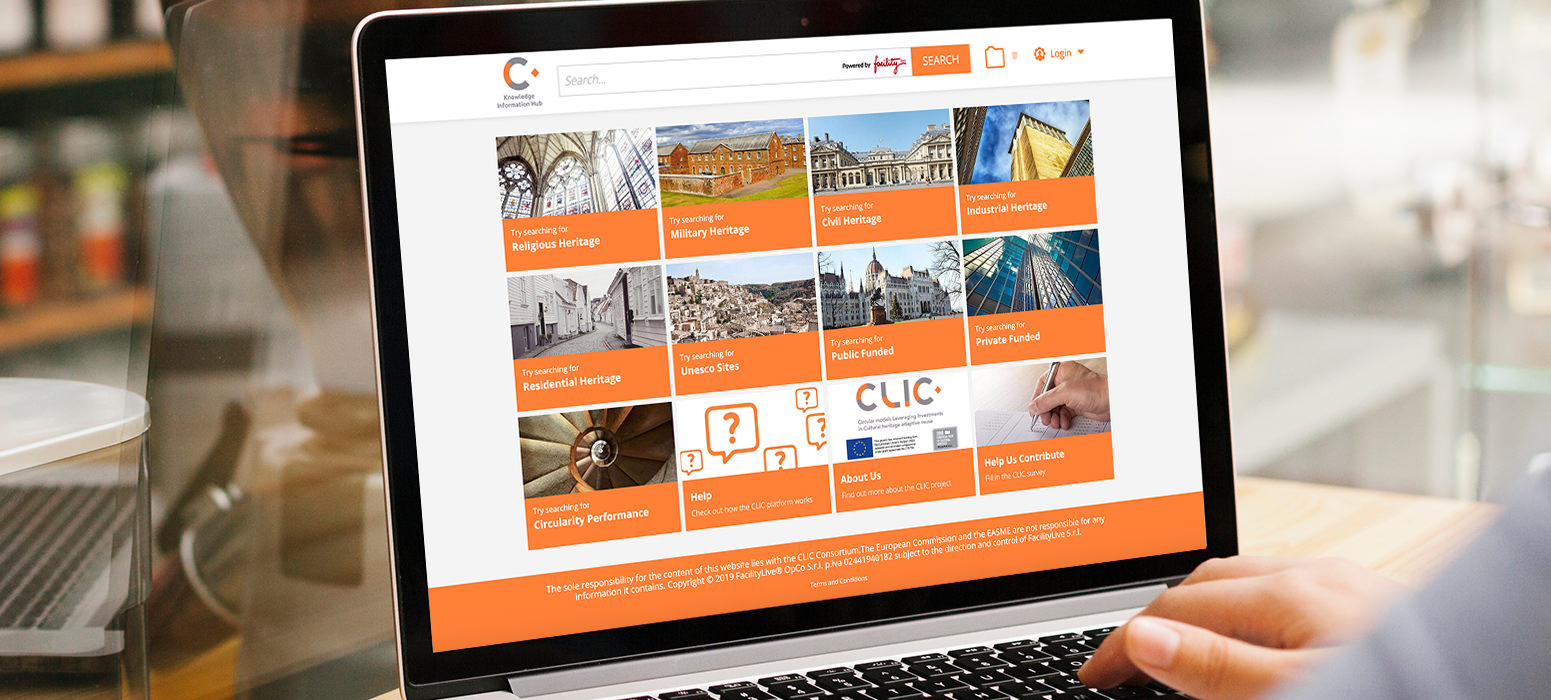
22Nov
Best of… cultural heritage adaptive reuse: CLIC Knowledge & Information Hub
The CLIC Knowledge and Information Hub platform provides a common space for researchers and practitioners to share and exchange knowledge about cultural heritage adaptive reuse, specifically in terms of “best practice”. Furthermore, it develops a pilot function based on requirements from the cities of Salerno, Rijeka, Amsterdam and Västra Götaland Region to showcase local reuse practices and “present” the abandoned heritage as assets/opportunities for adaptive reuse investments towards the implementation of a “circular city” model. The application in the four cities/territories, representing different geographic, historic, cultural and political contexts, is replicable in any other European (and not only European) city.
The first version of the CLIC Knowledge Information Hub is now available at www.clicplatform.eu, a knowledge sharing platform to learn from and share information about the best circular practices of cultural heritage adaptive reuse in Europe and beyond. The platform allows to search, collect and compare the characteristics and impacts of more than a hundred cultural heritage and landscape reuse projects facilitating the enrichment of the platform with new projects in a collaborative way. The platform not only empowers researcher and practitioners providing an open platform for cataloguing, presenting and sharing reuse projects but it is also of interest to anyone who wishes to look into the adaptive reuse practices and learn from their experiences such as citizens interested in seeing the projects of their city, local officials interested in possible new uses of buildings in their area of competence or be inspired by virtuous behaviour on other territories, investorsinterested in being able to evaluate the economic impacts of projects on the territory.
The platform organizes, manages and provides access to all the information on projects of cultural heritage adaptive reuse from European countries, provided by respondents to a CLIC survey. It collects and presents general information on the adaptive reuse project and its location, its structural characteristics and management aspects, including its uses/functions. The platform manages also aggregated data on different potential impacts of cultural heritage adaptive reuse in the perspective of the circular economy.
Through the platform, the user can consult information on single project, search specific groups of projects according to their characteristics. For instance, typology of the heritage building/site/landscape, type of owner before the adaptive reuse intervention, type of managing body, type of funding etc.
The platform contains also specific data on different aspects of circularity in the adaptive reuse of cultural heritage. They include, for example, information on energy efficiency, water recovery and materials reuse, information on the conservation of the cultural value of the building/site/landscape through the adaptive reuse intervention, as well as information on the economic, social, cultural, and environmental impacts generated by the adaptive reuse project in the local context. Furthermore, an assessment on circularity analyses the best practices of cultural heritage adaptive reuse in the perspective of the circular economy.
The platform has been developed by means of FacilityLive, an innovative technology for the organization and management of information that allows people to have a compelling user experience in information search. The technology finds exactly what the user is looking for treating information in the same way as humans do.
It organizes unstructured and heterogeneous data through an accurate cataloguing of all the information stored in any available sources, assists the user in an intuitive way when searching for information through human language interpretation of the search text and returns the results with a high level of relevancy, identifying the most significant and precious information.
The platform conveys the available information to the users in a simple and effective way that is highly intuitive, achieving maximum user experience. By using a cognitive approach to information, the platform provides immediate visibility of the most relevant results and their correlation in a single view. Conceptual areas promote results in a contextual manner instead of the usual sequential manner and the user has at his disposal conceptual and visual tools for an easy navigation and interaction with the results even if stored in remote locations without leaving the result page.
The end result is a new way of accessing cultural heritage information.
Have a look at some cultural heritage adaptive reuse projects in the CLIC Knowledge and Information Hub and explore the platform!
C-mine is a former coal mine that has been converted today into a contemporary art campus. Among the facilities located in the complex you can a find a visitor centre obtained from the old electrical building, a cultural centre in one of the old industrial buildings that hosts concerts, a theatre and other installations together with an art space situated in the old mining tunnels.
De Hoorn is a former brewery that has been transformed into a social hub used for hosting different functions. As a matter of fact, it can be used as a workspace and can be rent for the organization of parties and events. Furthermore, it hosts also a bar and a restaurant and offers room for temporary staying and meeting rooms.
Fort Vechten is a Dutch fort, built from 1867 to 1870 and part of the 85 km long “New Dutch Waterland defence System” which has been revitalized for educational, cultural and leisure purposes. Previously overgrown and forgotten heritage, it is today the largest national monument in the Netherlands. It is used as a multifunctional space for recreational purposes.There are also guided tours and recurring events every year.
Villa Campolieto is a Vesuvian villa situated along the Miglio d’oro, in the municipality of Ercolano. Acquired in 1977 by the Ente per le Ville Vesuviane, after 6 years of works, it has been restored to the original splendor and returned to public use. Today Villa Campolieto is an important international centre of art and culture hosting cultural visits, education and training centre, music and arts festivals, school educational activities and private events.
